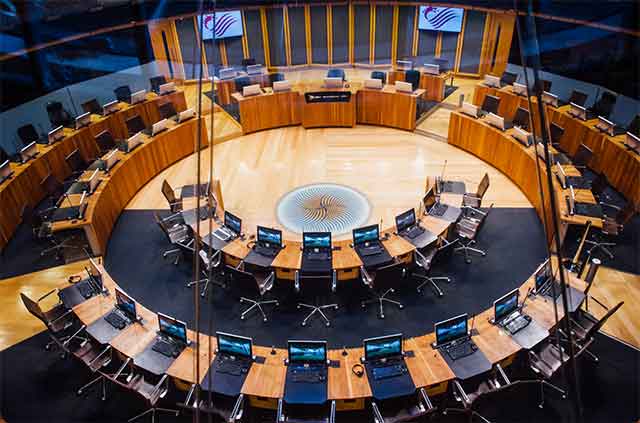The greyhound racing industry has hit back at plans to ban the sport in Wales, claiming data shows deaths have “more than halved” and injuries saw a “significant drop” last year.
Mark Bird, chief executive of the Greyhound Board of Great Britain (GBGB), accused animal welfare charities of citing “inaccurate, historic or even misleading” data to support the ban.
The Welsh Government has introduced a draft law to ban greyhound racing, leaving Wales’ last remaining track – the Valley Greyhound Stadium in Ystrad Mynach – facing closure.
Mr Bird told a Senedd committee the industry has made “leaps and bounds” on animal welfare since the Valley stadium became a GBGB-regulated track in 2023.
Labour’s Lee Waters asked about the Welsh Government using GBGB’s own data on dog injuries and deaths to justify plans for a phased ban on greyhound racing by 2030.
‘Secret state’
Mr Bird said: “Overall, the data is very positive in terms of where the transition is going… fatalities over that period of time have more than halved in terms of the numbers of dogs being put down on the track. But also last year we saw a significant drop in injuries as well.”
Giving evidence to today’s (October 23) culture and sport committee, which is scrutinising the bill, he criticised the Cut the Chase coalition of charities for presenting “out-of-date” data.
Pressed about figures for the Valley, Mr Bird said the regulator has decided not to publish disaggregated data for fear of tracks being targeted by animal rights activists. He was hesitant to supply the information as it could then become subject to transparency law.
Mr Waters responded: “It’s not a secret state, is it? We’re talking about a ban, surely it’s relevant to have that information in the public domain?”
Mr Bird told Senedd members: “Last year’s fatalities, the mean number of dogs that died at each of the tracks as a result of their injuries was six and as far as the Valley was concerned, they were below the mean.”
‘Too open’
He said GBGB’s data showed a 1.29% chance of a dog being injured in any given race, with the Valley track inspected at least twice a month during unannounced visits. He added that a vet is present at every race meeting.
Simon Franklin, chair of the Racecourse Promoters’ Association, described the industry as “too open” in reporting injuries that are not career-ending including a torn toenail.
Pressed about plans to ban the sport on animal welfare and ethical grounds, GBGB director Madeleine Campbell rejected a distinction between using animals in sport compared with food production, medical science or keeping them as pets.
Prof Campbell, a veterinary surgeon, said: “All of those human uses… expose animals to at least potential harms and, in fact, if you think about it, the benefits to humans from all of those – with the exception of using animals in medical science – are also trivial.
“We don’t need to eat meat or drink milk, we don’t need to have dogs as companions… so that argument around unique triviality, I don’t think stacks up.”
She contended: “The bill, as proposed, will do nothing to support positive welfare for greyhounds across their lifetimes.”
‘Popularity’
Asked about the popularity of the sport, Katie Bennison – general manager of Valley Greyhounds Stadium – said attendances vary but, during a typical week, around two hundred people attend the Wednesday or Thursday races.
She told the committee: “But then on a week when we race on a Saturday evening like we will be this Saturday, we’ll have around 150 people just at that meeting.”
Richard Brankley – head of operations for Satellite Information Services (SIS), the media rights distributor for Valley Greyhounds – said hundreds of thousands watch races remotely.
Mr Brankley told Senedd members racing live from the Valley is shown three to four times a week to customers in approximately 7,000 betting shops in the UK and Ireland.
He said domestic bookmakers stream every race live from the Valley and the SIS website, which has a dedicated stream, clocks up 250,000 unique visitors every month.
Mr Brankley warned the economic impact of a ban has been an “afterthought”.
‘Underground’
Mr Bird recognised a decline in popularity, saying: “Greyhound racing was probably at its most popular after the Second World War, we’re coming up to 100 years…
“But you’ll see that the shrinkage, a lot of that has been due to the fact that most racing tracks were in areas where there was high social deprivation – those areas have since been gentrified, ground has been taken back for housing etc.
“If you look at Wales… back in the 1960s there were at least 10 greyhound tracks… most of those would have been centred around mining [and] steel communities.”
He told the committee 19 tracks remain in the UK but he insisted it remains a popular sport, saying: “It may have shrunk but it’s a far more sustainable sport going into the future.”
Mr Bird, a former police officer, warned of unintended consequences from a ban, telling Senedd members: “The whole idea of driving something underground means you’ve got a bigger problem than you first started with.”

